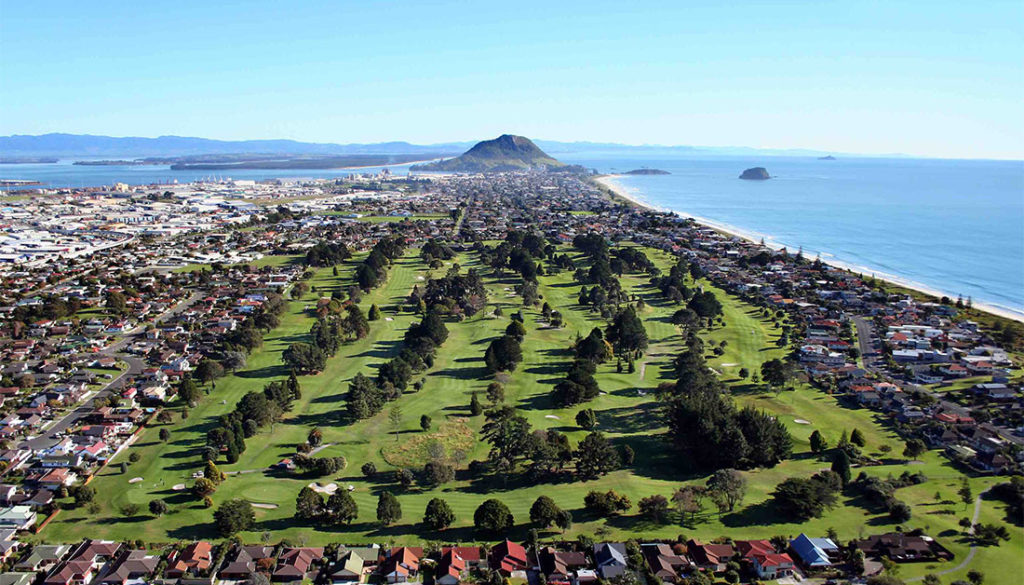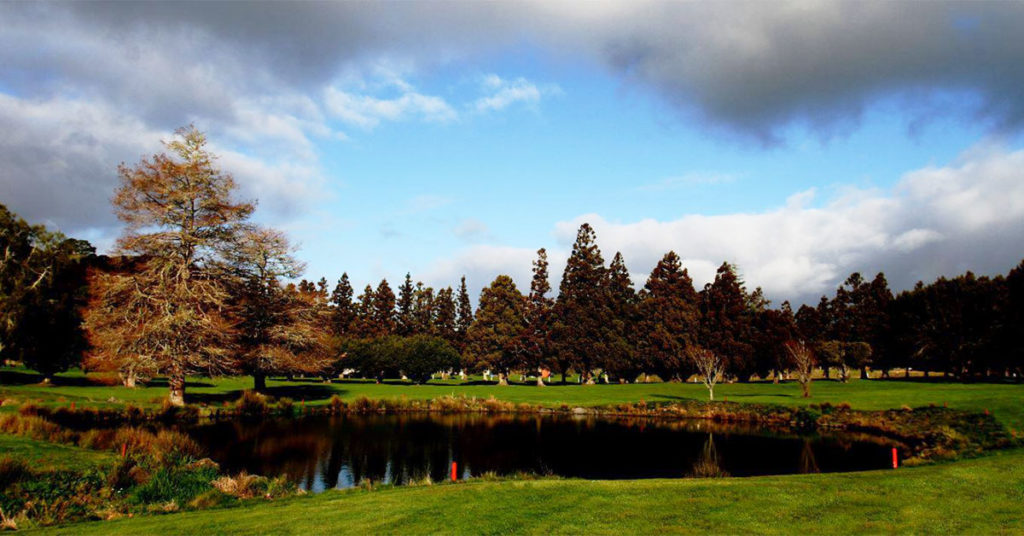It’s boom time around Mt Maunganui, but at the local golf club it’s no longer just boomer time.
With sunny skies and gorgeous beaches, Mt Maunganui and Tauranga have become popular lifestyle destinations for New Zealanders – and not just for the retirees who once dominated the area. At Mt Maunganui Golf Club, it’s taken a little while for that vibrant economic growth to trickle through but membership changes put in place five years ago are starting to reap rewards.
General manager Mike Williams says membership has increased by 20 per cent during the past five years – but nearly all the growth has been away from the traditional full-member category and in more niche, bespoke categories. Like many others, the club has diversified its range of membership options, including three and four-month deals, 20-round limits, and age-group categories that include different rates for under-25s, under-35s and under-45s. It’s the under-45 category that’s been one of the more interesting, controversial and successful.
“The age group system is not everyone’s cup of tea, but I think it has a lot of merit,” Williams tells New Zealand Golf Digest.

And particularly in Mt Maunganui, where the skew towards retired members, or veterans, was quite heavy until the club brought in lower rates for younger people, which helped balance the club’s demographic.
“The Mount has always had a reputation as a retirement haven and we were top-heavy with vets,” Williams said. “And it’s no secret that those under-45s are a tough section of the market – to get them committed and joining a club is hard. It’s dangerous to generalise, but barriers that come to mind are: busy at work, young family, big mortgage – all that stuff that happens between 25 and 45.
“The club looked at it and knew that if it wanted more activity from that age group, they’d need to look at the price point. It’s been successful based on our numbers in those categories.
“Some people think 45 is a bit high, but you don’t want a club that’s all veterans – and those under-45s who are attached to your club at that age are more likely to stay when they have time and money to become full members.”
“Those under-45s who are attached to your club at that age are more likely to stay when they have time and money to become full members.”
– Mike Williams, Mt Maunganui Golf Club
Naturally there was some resentment from the older players. Full membership costs $1,380, but under-45s pay $1,150, under-35s $799 and under-25s just $335.
“We’ve had people ask tough questions about why we do this – ‘Why isn’t there a gold-card discount?’ – but we’re meeting the market and as much as some people don’t want to hear it, that is the reality.”

Williams is wise enough to know that part of the club’s success with tiered rates through the age groups has a lot to do with being in a vibrant area that’s growing. But the club also made a decision to actively woo those potential new members with an appealing proposition instead of sticking to the one-size-fits-all approach.
“The club has the philosophy of creating a stepping stone to full membership for younger people,” he said. “We have 120 members between 19 and 45 and I think a lot of clubs would kill to have those kind of numbers in that age group.”
This approach of offering a variety of membership rates has been picked up by a lot of clubs – The Mount isn’t unique there – but not as many were as forward thinking as Mt Maunganui and are only just catching on to the benefits of a buffet offering.
Dean Murphy, chief executive of New Zealand Golf, says it’s only been in the past year that he’s seen a “tipping point”.
“What we’re continuing to see – and what we’re leading – is more innovation in membership packages and the continual unbundling of that one-size-fits-all membership package,” Murphy said.
“What we’re continuing to see – and what we’re leading – is more innovation in membership packages and the continual unbundling of that one-size-fits-all membership package.” – Dean Murphy, NZ Golf
“A year ago, there were a minority of clubs who were thinking that way; it’s flipped now where most clubs are thinking about what kind of diverse packages they can come up with to meet a diversifying market. There’s more diversification happening.”
Staying with Mt Maunganui as a good example, the club has also introduced a 20-round limit membership – just $595 or a shade less than $30 a round compared with an affiliate green fee rate of $50. This has been another popular category.

“We have 76 members in that category and five years ago that didn’t exist,” Williams said. “Would those 76 be a member of your club if that category wasn’t on offer? My gut feeling is no – they’d be somewhere else or they wouldn’t be playing golf. That limited-round option keeps people involved if they’re cash-poor or time-poor or just don’t want to play a lot.”
There are tight conditions around the 20-round membership compared to the age-group categories. For instance, there’s no play allowed on Saturday or Wednesday. “That’s to protect the full member,” Williams said. “If you pay different prices, you should be getting different value. People understand that it has to be fair.”
The shorter-term seasonal memberships have also worked a treat but one thing Mt Maunganui does particularly well is allow monthly payments, which are displayed clearly and boldly on the club’s website. In fact, the membership page of the website is something many clubs should aspire to. Everything – categories and pricing – is laid out in a user-friendly fashion.
Williams is convinced the monthly payment option is a necessity for any club, with nearly half Mt Maunganui’s members paying that way.
“It’s like your gym membership or Sky TV bill, it’s the way of the world,” Williams said. “Clubs that don’t offer that are really missing out. People like to pay for things monthly and golf needs to keep up with those trends.”
Research shows one of the biggest barriers to joining clubs – in any demographic: male, female, young or old – is the large up-front cost. Williams says it’s just human nature to look at a monthly fee of $100 as more affordable than an annual fee of $1,200, which can look like a “scary” number.
“Golf clubs should be marketing themselves like a gym does – it’s just human psychology. Our website lists monthly and annual fees and I’m seriously thinking of advertising just the monthly amount so it doesn’t look so scary.”
The only difference in cost for members between a pay-monthly and pay-yearly is a $30 administration fee to handle the multiple payments.
“It’s marketing in some ways,” Williams admits, “but it’s also taking a financial burden off people and that’s crucial to golf clubs. The idea is to make it easier. A lot of clubs do this begrudgingly but we’re quite happy for you to pay it monthly.”
Surprisingly, research shows cost is not the main factor that will cause a full member to quit – it’s more likely to be their poor scoring.
Murphy praises the work being done at Mt Maunganui, but New Zealand Golf is also taking some initiatives of its own, particularly with its focus on casual players.
“The casual golfer is becoming more formal,” Murphy says, adding that New Zealand is just starting to catch up to the rest of the world in this regard.

NZ Golf has all the data to show there’s a vast untapped playing base – and revenue stream – among casual golfers, and has introduced systems to make it easier for those players. The first thing NZ Golf did was set up a free registration system for casual players via its Love Golf website. That free registration allowed players to book tee-times through the dotgolf system, keep track of their scores and provide an “average” score (not a handicap). The uptake has been phenomenal with 105,000 people signing up. Murphy says the vast majority had never been part of any golf system before it.
The next step was to introduce an online club. For an annual fee of $120, plus a $30 set-up fee, players have all the access to the dotgolf system that club members have. They can book tee-times, have their scores recorded, have an official handicap and they can play anywhere they like at affiliate rates. Plus, new members receive a sleeve of golf balls and a Love Golf hat – together valued at $50. The only restriction is that anyone who registers cannot have been a member of a club for the previous year. There’s a pay-monthly version that costs $15 a month and the sign-up procedure for both is simple.
The program was launched without fanfare and in its first six months attracted 1,100 paying members, making it well on track to hit NZ Golf’s initial annual target of 1,500 to 2,000 members.
“We brought that in last October to test it and see it if had any resonance,” Murphy said. “We wanted to take it slow and organically and test it as we go. And it’s going really well; the customers are right into it and the clubs are largely jumping in behind it. They see it as a way to get casual players engaged and perhaps bring them across to full membership in the future. Lots of clubs are tuning into the casual golfer market.”
“They see it as a way to get casual players engaged and perhaps bring them across to full membership in the future. Lots of clubs are tuning into the casual golfer market.” – Dean Murphy, NZ Golf
All the same, it has met some mild resistance from clubs that were concerned the system was ‘cannibalising’ prospective members.
“One of the key pains was clubs saying, ‘Hey, you’re out there competing with us,’ but what they’ve now understood is that it’s for people who don’t want to be club members, people who don’t want to pay $1,000 and play at one club all the time. This is for people who want to play a round at different clubs and don’t want an up-front commitment or a full-time commitment, which is shown by an average of people playing just six times in the six months it’s been running – or once a month.”

If the current trial program continues past year one, the plan is for 50 per cent of the revenue to go back to clubs as rebates off their normal levy paid to Golf NZ. And the good news for those clubs worried it will hurt them is that so far 40 registered members have gone on to take out a full membership.
The future for the online system – or virtual club – is exciting with friends or work colleagues able to create their own mini-clubs within the wider system.
“The next evolution of it will see you be able to set up your own club and run your own leaderboards and competitions – internationally there’s a lot of movement in that direction,” Murphy said. “We really like that idea of people setting up their own online competition as part of the mothership and running their own competitions.”
The virtual club concept has been a huge success for NZ Golf at junior level, known as Futures. The first was trialed in the Queenstown region last year and has now spread to five other regions, with more coming on tap.
Juniors pay a single membership fee but get access to a range of different clubs in their region. It works well in less populous or geographically broad regions and has spread to Dunedin, Whanganui, Rotorua, Northland and Canterbury. It helps create a “critical mass” of junior players, so fewer resources are needed to provide coaching and competition and it lightens the load on individual clubs.

The same concept of a single membership but with access to a range of clubs is another way of encouraging casual players to take a more formal approach to playing. A good example is in the north and west Auckland where Helensville, Mangawhai, Northland, Warkworth, Whangaparoa and Whangarei have joined forces to create the Northern Passport. Each of those courses is very good in its own right, but equally each would struggle to convert casual visitors into full members. Yet combined they have a generous offering: an annual subscription of $350 entitles ‘members’ to one free round of golf at each of the participating clubs plus guaranteed discounted green fees of $20 for each additional round as well as an official handicap.
In two years, more than 200 people have signed up – and arguably they are people who would not take out a full membership at any single club – and their participation has seen increased revenue for food and beverage at all the clubs.
Twilight and off-peak memberships also work well, as do family memberships that give parents the opportunity to bring their children and the other way around: if the children play, their parents may be motivated to play as well.
Other suggestions for clubs include changing the way they use a membership fee. For instance, an annual fee could be converted into credits that the player uses up during the year. The club decides how many credits a round will cost, with Saturday rounds costing more than weekday rounds, for example, or changing the value from summer to winter. NZ Golf says that deal strikes a good balance between a full membership and pay-for-play.
It’s all a matter of being creative in your thinking but it also requires good financial management skills, says Mike Williams of Mt Maunganui.
“One thing clubs need to balance out – especially if your new offerings are at a reduced rate – is that you might have good numbers but your overall revenue might be the same or even drop,” he says. “Reduced options come with reduced revenue but they also bring in more people, which is good for the atmosphere at the club, good for spending in the restaurant, bar and pro shop, and there are more potential volunteers.
“While our full membership is down slightly in recent years, there’s been great growth in other categories that didn’t exist five years ago. So, overall, we take more revenue now than five years ago.”
“While our full membership is down slightly in recent years, there’s been great growth in other categories that didn’t exist five years ago. So, overall, we take more revenue now than five years ago.” – Mike Williams, Mt Maunganui Golf Club
And lest anyone forget that traditional full-paying members are still important, NZ Golf is working hard with clubs to ensure they retain the members they do have.
Last year, overall membership in New Zealand was almost dead flat, with a decline of 0.4 percent, a sign that clubs are doing well at retaining members, especially given the skew towards an older demographic. There are roughly 95,000 full members across New Zealand but the loss of about 8,000 members last year has been offset by an increase in registered casual golfers, up from 88,000 to 105,000 – an increase of 20 per cent. Add to that the 1,100 paid-up casual players and golf can claim to have more than 200,000 registered participants. But as Murphy notes, that’s only about 50 per cent of the people who play golf in some form every year, with government figures suggesting the true golf market includes 400,000 people.
NZ Golf is working hard with clubs to make sure they know how to look after current members, to ensure they don’t get bored and continue to enjoy playing at the same track week after week. Among the ideas being touted is changing the length of the course by adjusting tees. There are a variety of ways clubs can do this. If the weather is bad – say a strong wind is blowing – the club might shorten some key holes. A reduction of 20 metres won’t affect the course rating but might make a big difference to members if conditions
are difficult.
Creating hybrid courses by using a mix of front, middle and back tees in one round spices up the day and keeps members on their toes. Clearwater Golf Club does this to great effect. It has two hybrid courses known as the East and West that shorten or lengthen the course, depending on the prevailing wind for that day.

In general, shorter courses encourage faster play, which most people want. NZ Golf offers a service where a course can be re-rated for a short version. Time spent on the course is one thing – slow play is a bug bear everywhere – but scoring is also critically important for keeping members motivated and enjoying the game. Surprisingly, research shows cost is not the main factor that will cause a full member to quit – it’s more likely to be their poor scoring. For that reason, clubs should pay attention to members’ scores and work out ways to help or encourage those who might be struggling.
Keeping members engaged is also crucial. If you’ve got a lot of members that are playing less than once a month, it could indicate a problem. These members are particularly at risk if their handicap has started to rise as well.
In both instances, a leaf out of the Les Mills gym handbook helps. Les Mills is passionate about communicating with members who have paid up but are not showing up by actively calling those members to check in on them, to help them and motivate them to get the most out of their membership. The gym franchise realises it’s not in anyone’s interests to have members paying a large fee but not participating.
It’s not in anyone’s interests to have members paying a large fee but not participating. A disenchanted golf club member can be turned around with something as simple as a call from the manager or pro.
A disenchanted golf club member can be turned around with something as simple as a call from the manager or the pro to see how they’re going. After all, making people feel valued never gets old. A phone call has a personal touch, as does some free coaching, a sleeve of golf balls and a free round for a member’s guest. A small cost can reap big dividends if the member signs up again the next year.
The bottom line for golf clubs is to be creative, and to actively pursue new players by finding out what they want rather than sitting back and hoping they’ll walk through the door. At the same time, they can’t forget to invest time and energy with their full-fee members. It’s as tricky as hitting a golf shot balanced on one leg, but the risk of not doing anything is that you’ll fall over anyway.




